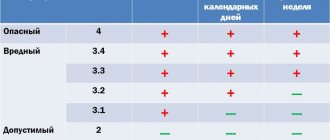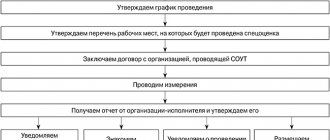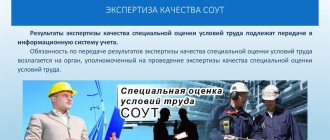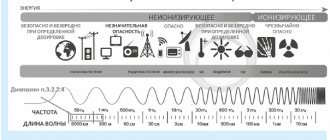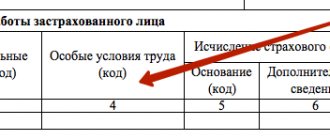Optimal
According to this classification, the most favorable working conditions are optimal (class 1), that is, under which there are prerequisites for maximum labor productivity with minimal impact of production factors on the human body.
When working in such an environment, the health of workers does not suffer from the negative influence of the labor process; the influencing factors are within safe limits provided for the population (do not exceed background values).
A video about workplace certification and the consequences of failure to do so.
Acceptable
Acceptable labor parameters include those production factors in which the negative impact does not exceed the background values regulated for workplaces. The health of a working person after potential exposure to the body is restored by observing the rest time or by the beginning of the next shift.
The exposure does not have a negative impact on the health of employees either in the short term or in the long term, and does not affect their reproductive function.
As a rule, long-term exposure to unfavorable environmental factors affecting the team leads to poor health and the formation of occupational diseases. Such factors are classified as harmful or dangerous working conditions.
Optimal and permissible conditions are characterized by relative safety for long-term stay of people and performance of work functions.
Third class
Harmful working conditions (class 3) are working conditions under which the levels of exposure to harmful and (or) hazardous production factors exceed the levels established by the standards (hygienic standards) of working conditions, including:
- Subclass 3.1
Harmful working conditions of the 1st degree - working conditions under which the employee is exposed to harmful and (or) dangerous production factors, after exposure to which the altered functional state of the employee’s body is restored, as a rule, after a longer period than before the start of the next working day (shift), cessation of exposure to these factors, and the risk of health damage increases.
- Subclass 3.2
Harmful working conditions of the 2nd degree - working conditions under which the employee is exposed to harmful and (or) dangerous production factors, the levels of exposure of which can cause persistent functional changes in the employee’s body, leading to the emergence and development of initial forms of occupational diseases or occupational diseases of mild severity (without loss of professional ability) arising after prolonged exposure (15 years or more).
- Subclass 3.3
Harmful working conditions of the 3rd degree - working conditions under which the employee is exposed to harmful and (or) dangerous production factors, the levels of exposure of which can cause persistent functional changes in the employee’s body, leading to the appearance and development of occupational diseases of mild and moderate severity (with loss of professional ability to work) during the period of working activity.
- Subclass 3.4
Harmful working conditions of the 4th degree - working conditions under which the employee is exposed to harmful and (or) dangerous production factors, the levels of exposure of which can lead to the emergence and development of severe forms of occupational diseases (with loss of general ability to work) during the period of work.
Compensation for health hazards
The legislation of the Russian Federation provides for the availability of compensation for employees whose work involves exposure to harmful and dangerous working conditions.
The employer has the right to independently choose the type and amount of compensation based on the Labor Code:
- Additional annual paid leave.
- Increase in wages by no more than 4% of salary.
- Free treatment and wellness.
- Issuance of personal protective equipment.
- Reducing labor time by reducing working hours.
How to find out the level of danger?
Special working conditions: what are they?
In total, there are 4 types of conditions:
- Optimal.
- Acceptable.
- Harmful (divided into harmful degrees 1, 2, 3, and 4).
- Dangerous.
Important! Safe working conditions are characterized by the absence of any threats to the health or life of the worker. The Legal Code states that an employee has the right to move to another department or change workplace in order to ensure safety at the enterprise.
Employment contract concept
According to Article 58 of the Labor Code, in the case where neither party has demanded termination of a fixed-term employment contract due to its expiration and the employee continues to work after the expiration of the employment contract, the condition on the fixed-term nature of the employment contract loses force and the employment contract is considered concluded on indefinite term.
There is no such concept; there are only two parties to an employment contract - the employer and the employee. And you are just the recipient. Bailiffs can check. Contact them - why do you receive so little alimony, Article 81 of the RF IC. The labor inspectorate can also check only for violations of labor legislation. In particular, under Article 133 of the Labor Code of the Russian Federation, he also has the right. And bring him to administrative responsibility. “Labor Code of the Russian Federation” dated December 30, 2001 N 197-FZ (as amended on February 5, 2018) Article 133. Establishment of the minimum wage
▪ The amount of a fixed sum of money is determined by the court based on the maximum possible preservation of the child’s previous level of support, taking into account the financial and marital status of the parties and other noteworthy circumstances.
| ConsultantPlus: note. On identifying the constitutional and legal meaning of Part 1 of Art. 133 see Resolution of the Constitutional Court of the Russian Federation dated December 7, 2017 N 38-P. ConsultantPlus: note. The procedure and timing for a gradual increase in the minimum wage are established by federal law (Article 421 of this document). The minimum wage is established simultaneously throughout the entire territory of the Russian Federation by federal law and cannot be lower than the subsistence level of the working population. |
According to Article 59 of the Labor Code of the Russian Federation (hereinafter referred to as the Labor Code), by agreement of the parties, a fixed-term employment contract can be concluded:
Hello. The employer faces administrative liability under Art. for “black” wages. 122-123 Code of Administrative Offenses of the Russian Federation.
This means that fixed-term employment agreements can be concluded with teaching staff.
Characteristics of harmful and dangerous conditions
According to the Labor Code of the Russian Federation, an enterprise can be considered harmful only if its personnel are exposed to the following unfavorable conditions:
- Working with tools and equipment that cause strong vibration (jackhammer, hammer drill, etc.);
- The presence of dust and other similar manifestations in large quantities;
- Increased noise level;
- Insufficient lighting of the workplace;
- Being in the same room with poisonous, chemical or toxic substances, the concentration of which exceeds the norm;
- High humidity;
- The presence of viral bacteria and spore microorganisms (salmonella, fungus, etc.).
The listed factors can be used to characterize harmful working conditions. But the concept of danger at work includes slightly different criteria:
- High altitude;
- High voltage;
- Emergency structures;
- Ice, flood, fire and other natural disasters.
It is important to know! It is this list of factors that determines the degree of harmfulness of each enterprise, assigning it one of the four available hazard classes.
Legislative acts on the topic
| Art. 56 Labor Code of the Russian Federation | On the employer’s obligation to provide proper working conditions for employees |
| Art. 57 Labor Code of the Russian Federation | On the mandatory inclusion in the employment agreement of a clause describing working conditions |
| Art. 14 Labor Code of the Russian Federation | On the classification of working conditions |
| Art. 224 Labor Code of the Russian Federation | On payment of compensation for harmful working conditions |
| Art. 147 Labor Code of the Russian Federation | On the minimum amount of compensation for harmful work |
List of occupations classified as hazardous
The list of hazardous working conditions established by the state can be applied not only to individual professions, but also to entire industries. Namely:
ProfessionIndustryHarm received
| Engineer, geologist, surveyor, geophysicist, hydrologist, miner, fastener. | Mining | There is a possibility of being hit by a rubble. Additional factors: poor lighting and increased concentration of dust. |
| Crane operator, steelmaker, blast furnace operator, smelter, caster, heater | Metallurgy | There is a high chance of intoxication of the body. Also considered unfavorable conditions are high temperatures and harmful fumes. |
| Chemist, technologist, biochemist, laboratory assistant. | Chemical production | Constant exposure to toxic substances. The chance of severe burns or intoxication increases. |
| Designer, tester, gunsmith. | Ammunition making | There is a possibility of injury when interacting with firearms or explosives. Additional criteria: increased noise level. |
| Geologist, drilling machine operator, engineer. | Oil production | Systematic exposure to toxic fumes on the body. There is also a chance of getting burns when working with flammable liquids. |
| Flaw detector, electrician, installer, engineer. | Electrical engineering | There is a risk of serious injury when exposed to high voltage. There is a risk of death. |
| Carpenter, fitter, painter, installer, asphalt paver, slinger, foreman, crane operator, engineer. | Construction | The most dangerous class, which includes a number of unfavorable conditions: loud noise, presence of dust and chemicals, height, work with emergency structures. |
| Virologist, pharmacologist. | Healthcare | There is a chance of contracting some viral disease. |
| Layout designer, printing specialist, folder, cutter, technologist. | Printing | Systematic exposure to loud noise on the body. Additionally, there is contact with toxic substances. |
| Engineer, installer, designer, radiochemist, turner, milling machine operator, researcher, electrician. | Atomic industry | Constant contact with radioactive substances of increased danger. |
| Driver, flight attendant, mechanic. | Transport | There is a chance of serious injury, even death, in an accident. Sometimes working in this area involves poor lighting and increased noise levels. |
| Firefighter, Emergencies Ministry employee, diver. | Rescuers | High probability of causing irreparable harm to health. From time to time, negative factors such as elevated temperature, insufficient lighting, and evaporation of toxic substances may be observed. |
| Gas and electric welder | Welding work | Increased eye strain and contact with high voltage. |
As you can see, not all positions related to hazardous industries are hazardous according to the Labor Code of the Russian Federation. Therefore, before applying for financial compensation, you should familiarize yourself with the table above.
The procedure for determining unfavorable working conditions
The procedure for special assessment of working conditions (SOUT), provided for by Russian legislation, helps determine working conditions from the point of view of their impact on the employee’s body. It is an analysis of working conditions in the workplace. The latter is understood as the place where the worker must be for the purpose of working under the direct or indirect control of the employer. SOUT is aimed at achieving the following goals:
- identification of unfavorable factors;
- establishing the degree of their influence on body functions;
- identifying the magnitude of deviation of real values from standard requirements;
- assessment of the effectiveness of the use of personal protective equipment and protective equipment.
Benefits for hazardous working conditions
Employees are entitled to benefits.
Those factors that affect employees of an enterprise during work often have an adverse effect on the body, disrupting its proper functioning. Sometimes unfavorable conditions in the workplace can threaten not only the health, but also the life of the employee.
Therefore, every employee who performs his or her job duties in hazardous conditions is entitled to benefits. They are calculated by the accounting department. The size and form of benefits are determined depending on the class and degree of harmfulness of working conditions.
Benefits that are due for working in hazardous conditions: timely pension on special conditions, provision of milk and other products to employees, changes in working hours, monetary compensation.
For example, a normal work week is 40 hours. If hazardous working conditions exist, the work week is reduced to 36 hours.
Labor legislation allows a significant reduction in hours in the presence of exposure to harmful factors.
If the working week is 36 hours long, one shift can last no more than 8 hours. If the work week is 30 hours, then the shift can last no more than 6 hours.
Lecture 5: Designing conditions for personnel activities
Control system design
Organizational design concept
Organizational design is the activity of forming individual divisions and the management apparatus as a whole in the form of a set of positions of managers, specialists, technical performers who help the first person manage the organization, vesting them with the necessary powers, creating management mechanisms and conditions for their functioning.
Before starting work on organizational design, it is necessary to find out the nature of internal and external relations, the number and general characteristics of management objects, the number of divisions, their staffing and functions, territorial location, and interrelations.
Main directions of organizational design:
- Composition - determination of the main characteristics of the organization, the general structural diagram of the management apparatus, taking into account technological, information and other relationships, main goals, functioning mechanism, principles of selection and promotion of personnel, remuneration, incentives. All this creates the basis for more detailed organizational design.
- Structuring is the determination, based on organizational goals, of the composition of the main divisions (departments, sectors, bureaus, groups), their powers, internal structure, connections, specific tasks facing them as a whole, jobs and positions.
The process of forming units is called departmentalization, the modern principles of which are:
- quantitative (divisions are created based on the optimal number of people needed to solve the task, as well as the ability to properly manage them);
- temporary (units unite people who work at the same time - shift, watch);
- technological (the creation of divisions is based on the production process or a relatively independent part of it; this is how workshops arise, and within their framework - individual sections);
- professional (when people with similar specialties or engaged in the same type of activity unite “under a common roof”);
- functional (in large organizations, departments are combined into groups in accordance with areas of activity);
- divisional (divisions that have the status of legally independent enterprises are distinguished on the basis of servicing a particular market or region, release of a specific product, stage of the life cycle).
These divisions (as well as the organization as a whole and individual areas of its activities) are management objects that have their own governing body. Thus, the basis of the management structure of the organization is built on the object principle. However, the vertical management structure of the organization is also built in accordance with the lines of authority that higher units exercise in relation to lower ones.
Approaches to the formation of organizational structures are:
- Normative-functional, which assumes that a specific structure is created (improved) on the basis of a standard one, adjusted taking into account the influence of a number of factors (scale, nature, degree of specialization of production, number of employees).
Standards for the formation of divisionsSubdivision Technical Economic Are common Department More than 12 More than 8 More than 5 The Bureau 6–11 5–7 3–4 Group 2–5 2–4 2 - Functional-technological (based on the rationalization of information flows and technology for processing it) takes into account the specific situation, but is extremely labor-intensive.
- Regulatory - development and official registration of mandatory requirements for the parameters of the organization, individual divisions, management apparatus, internal processes, procedures. Ensures the uniform implementation of repetitive actions, regardless of the personal characteristics of those who perform them. The objects of regulation are:
- communications and interaction between and within departments;
rules, procedures and time standards for performing operations;
- rights, duties, responsibilities of departments and employees, their subordination;
- design number and qualification composition of personnel;
- labor intensity of basic work;
- distribution of specific tasks;
- performance indicators;
- organizational standards;
- management technologies;
- information, its content, frequency of receipt or provision, etc.
The regulation solves the following problems:
- creates a regulatory framework for the formation of a management structure, horizontal and vertical relationships, subordination, etc.;
- establishes quantitative characteristics of management processes at all levels;
- sets the content, volume, frequency and forms of incoming information necessary to complete the work, helps eliminate redundant or unnecessary information;
- ensures the distribution of tasks between structural units and individual employees, establishes their rights, duties and responsibilities, eliminates unnecessary labor functions and operations;
- organizes management techniques and methods, the procedure for working with personnel, their training and advanced training;
- determines the conditions for economic incentives.
The basis of regulation is the regulation - an organizational provision that very clearly prescribes the types of actions, conditions and restrictions on their implementation. The following regulations are used in personnel management:
- production (production standards, service standards);
- technical (safety requirements);
- economic (procedure for calculating wages, bonuses);
- social (rules for providing guarantees, compensation);
- organizational (regulations on departments, job descriptions, qualification characteristics, staffing schedules, work schedules, reception of visitors, etc.).
Orientation can be numbered (codes for folders in the archive), verbal (a sign on the door with the name of an employee), verbal-numerical, which is a combination of both, symbolic (symbolic drawing), graphic (schemes for evacuation of personnel in case of fire), color (various painting walls on different floors).
The result of work on organizational design is a set of design documentation for building the organization of work in an organization (division), called an organizational project. Its main blocks are:
- division of labor
- organization of workplaces
- organization of labor processes
- working conditions
- requirements for performers
- norms and regulations, etc.
